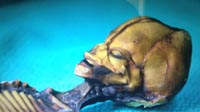 Atacama Humanoid: Stanford-Geneticist Says Specimen "not worth scrutiny"
2013 06 18
Atacama Humanoid: Stanford-Geneticist Says Specimen "not worth scrutiny"
2013 06 18
By Elizabeth Leafloor | Red Ice Creations
The documentary SIRIUS has intrigued and shocked many, and has stirred debate about the scientific findings regarding the ’Atacama Humanoid’.
Recently, daily German science news site GreWi.de followed up with Dr. Garry Nolan, the Stanford geneticist that headed the investigation into the mummified remains.
grenz|wissenschaft-aktuell reports:
Since the documentary movie "Sirius" showed the first results of an investigation of a just 15 centimetres tall little mummy discovered in the Atacama Desert, analysed in depth by medics and geneticist of Stanford University, it created heavy controversies and misconceptions about what those (preliminary) results truly meant for an understanding of the specimen as well as about what the participating scientists think it is.
Portions of the GreWi.de interview follows (and the full interview in English can be found here):
GreWi: Dear Mr. Nolan, many news-items that followed the first showing of "Sirius" quoted other scientist, who were not part of your original investigation, declaring that the mummy of the so-called "Atacama Humanoid" is nothing else that a premature delivered foetus with heavy mutations and syndromes. But according to you and your colleague Dr. Ralph Lachman (who is a respected authority on skeletal dysplasias), the original being did live up to an age of 6-8 years and could therefore not be explained as being the mummy of an early aborted foetus suffering from some kind of progeroid syndrome?
Nolan: First it would be wrong to interpret that either Dr. Lachman or I "concluded" anything about the age of the specimen. The documentary was a window into how science is done - with the full understanding that I was giving the viewers "dynamic" speculation over time of my interpretations of the specimen - with whatever data I had at the time. It was my attempt to show people how one can do good science in controversial areas. As such, one has to consider, accept and then sometimes later reject, conclusions as new evidence appears.
Thus, any speculation you hear from me in the movie (Sirius) is a "point in time" - and you will even hear me contradict my own conclusions later in the documentary as new data is revealed.
My early statement on camera that this (being) might have been eating, breathing and living is no longer a conclusion I feel strongly about. Dr. Lachman never said that, so it would be incorrect to broadly include him in what I (personally) stated tentatively. I repeat - the tenet and basis of the documentary approach was to hear me "speculate" - not conclude. Even at the time of the "last interview" in the documentary we only thought the specimen’s bones "appeared" to suggest an older specimen than the size would lead one to believe.
The bone results are the only thing right now that suggests it is older. “Suggest” does not equal “prove”. That the bone epiphyses are “apparently” 6-8 years does not “prove” it was 6-8 years. It just makes the question worth answering as to “why” the bones look older. Is it an artifact of the mummification or drying process? Some new form of rapid aging? I don’t know and I suspect we won’t ever truly know without a lot more work. And I am not sure the specimen, at the end of the day, is worth that much more worry and scrutiny.
The Atacama Humanoid, Dr. Dolan goes on to say, will undoubtedly be classified as fully human:
GreWi: In "Sirius" you explain that the analysis of the mitochondrial DNA (mDNA) revealed without any doubt that the being’s mother was a human woman indigenous to the Chilean area where the mummy was found (Haplogroup B2A). What is your analysis so far saying about the father?
Nolan: We are comparing the normal DNA with the known allele frequencies of indigenous natives of the South American continent. Yes, I expect that the DNA analysis will end with this being a human and the Father also a native of the area. While I am open minded about the result, I think it is safe to now conclude this specimen is, without a doubt, human.
The Atacama Humanoid does not need to originate from the stars to be an amazing thing. Surely understanding this being, a human and thus a part of the human condition, is vitally important to our understanding of humanity at large. Indeed, it would not be outside the realm of possibility that another such human could be born. In fact, a recent article by Lee Speigel suggests that the Atacama Humanoid may not be the only specimen of it’s kind.
Either way, a scientist’s suggestion that it’s not worth further ’worry or scrutiny’ is a strange position to take. Why end research or stifle inquiry into such an important issue? MORE information is needed, not less.
Just as the discovery of Homo floresiensis ("Flores Man", nicknamed "hobbit") as a new hominidae species was a vital step towards filling in the gaps in our knowledge base of human origins, so too should the Atacama Humanoid be examined at length for the same purposes.
Criticisms of the Atacama Humanoid largely echo those faced by archaeologist Mike Morwood who discovered the Flores Man, and Lloyd Pye in his research into the StarChild Skull; That in these cases the remains are only mutations, pathologies of anatomy, thyroid malfunctions, or syndromes. However, Dr. Nolan himself has remarked that, "the observed abnormalities do not fall into any standard or rare classification of known human pediatric disorders".
Red Ice Radio spoke with Dr. Steven Greer, filmmaker and founder of The Disclosure Project, regarding his controversial documentary:
By Elizabeth Leafloor, Red Ice Creations
